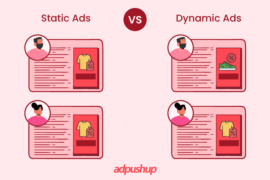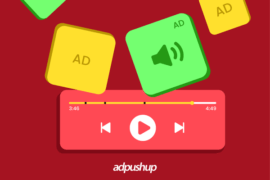Programmatic video is an important piece of the programmatic advertising puzzle and offers brands unprecedented access to video audiences. Here’s what you need to know about programmatic video.
Programmatic video is picking up steam and it’s easy to see why. Everyone is getting on board with this new way of advertising as they see it as a way to actually get engagement.
Programmatic video advertising is growing at an alarming rate. More brands are jumping on board to utilize the benefits of programmatic video advertising.
As reported by eMarketer, US advertisers have seen a significant boost in their spending, with an increase from $52.17 billion USD in 2021 to $62.96 billion USD in 2022. This trend is expected to continue, with projections estimating a spend of $78.45 billion USD in 2023.

Image source – Marketing Charts
This growth in advertising spending highlights the importance and impact of marketing efforts in today’s market.
With programmatic videos being new, many advertisers still believe that there is a lot of confusion. This is generally about:
- How does it work?
- How it is different from other types of advertising?
- Why should advertisers choose to go with it?
This blog article will shed some light on how programmatic video works, various video ad solutions, and common misconceptions about programmatic video.
But before that, let’s take a quick recap and learn exactly what is programmatic video.
What is Programmatic Video?
Programmatic video refers to the automated process of buying and selling video advertising space through programmatic technology.
It uses data and algorithms to determine the most effective placement for video ads and target specific audience segments.
The process involves real-time bidding, where the system selects and places an ad based on the following factors:
- Available inventory
- Audience data, and various
- Cost
- Performance
- Relevance
This allows for a more efficient and data-driven approach to video advertising compared to traditional methods, leading to improved targeting, greater cost efficiency, and better ad performance.
Essentially, ad impressions of all sorts can be traded via algorithms (aka machines/computers). Video ads are no different.
To put it in another way, Automated, real-time buying and selling of video ads is programmatic video. That’s all.
Now, let’s delve deeper into the programmatic video and see why you should consider going for it in 2023.
How Does Programmatic Video Work?
Much like any programmatic advertising type, programmatic videos work are purchased automatically and are delivered through programmatic advertising platforms.
Here’s how it looks like:
- Advertisers define their target audience and campaign goals.
- The programmatic platform then uses data and algorithms to select the appropriate publisher.
- After that, the programmatic platform decides the most effective times to display the ads.
- Once it’s done, the ads are delivered in real-time, using data from various sources like cookies.
In comparison with the traditional methods of buying video ads, or any type of digital ads, it allows for a more efficient and effective ad delivery process.
Also Read – Programmatic Advertising: A Quick Guide for Publishers
Why Should You Choose Programmatic Video Advertising in 2023
Programmatic video advertising not only streamlines the ad buying process by eliminating the middleman, but it also offers numerous other benefits to businesses. Let’s take a look.
Increasing popularity
Yes, you have heard it right. In fact, one of the most dominant ad formats in social media is expected to be video advertising.
According to eMarket, video advertising will account for 35% of social media ad spending in 2023. Moreover, you will be surprised to know that about 93% of companies attracted new customers because of video advertising.
Great Solution for B2B Marketers
A study by Accenture found that 94% of buyers conduct online research, seeking solutions at any time and place. In response, B2B marketers are utilizing video to effectively reach professionals in their desired locations.
Through video, B2B marketers have a chance to showcase their creativity and differentiate their messaging, making it a valuable tool in their marketing strategy.
Data-Driven Optimization
With programmatic video advertising, real-time data is collected and analyzed to understand how the campaign is performing and to identify areas for improvement. This information is then used to adjust the campaign in real time, allowing for continual optimization and better results.
Cost-Effective
If you’re someone who has not tried programmatic video and is looking for affordable ways of marketing, the programmatic video method is worth choosing.
Automation often results in lower media costs, making programmatic video advertising a cost-effective option for businesses of all sizes. Speaking of automation, it also takes us to our next reason, which is time-saving.
Improved Engagement
Video is a highly engaging format that can help to capture and hold the attention of viewers, improving the impact of advertising. It is because videos are usually interactive and easy-to-consume type of content,
Time-Saving
Both advertisers and publishers stand to benefit from the efficiency of programmatic video advertising. By automating the advertising process, programmatic eliminates the need for manual negotiations and searching for the right match.
This means that both advertisers and publishers can save time and focus their efforts on other important tasks.
Increased Accuracy
Automation reduces the risk of manual error, ensuring that advertisements are placed in the right context, reach the right audience, and deliver the intended message. This increased accuracy leads to better results and higher engagement, making programmatic advertising a more effective and efficient option for businesses.
Types of video ads used in Programmatic Video Ads
There are three most common types of video ads used in programmatic advertising. Take a look.
Instream
Instream video ads are ads, which are presented to the users within the player. You can expect these ads to be shown up before the actual video content streams, in the middle of the video content, or after it ends.
These are linear video ads with various starting points that disrupt video content to play. Further classified as pre-roll, mid-roll, and post-roll.
Outstream
Outstream video ads appear in the midst of the content of any website. For example, a Youtube video, which we usually come across while scrolling through a blog or an article.

Image Source – Think with Google
These types of programmatic videos don’t interrupt video content but are displayed on top of the content.
In-display (rich media/in-banner/in-feed/etc)
Third, in-display ads are another type of video ad generally used in programmatic advertising. These ads appear within an online display banner. Here, video creatives are served in the display ad unit.
Also Read – Types of Video Ads, Best Practices & How Are They Served
5 Trends of Programmatic Video Advertising
1. Increasingly Popular Programmatic Channel
According to eMarketer, US advertisers showed significant growth in their investment in programmatic video advertising. As mentioned earlier in the blog, the value in the current year is expected to reach $74.88 billion USD.
2. Increased adoption of OTT and CTV
Second, with the rise of over-the-top (OTT) and connected TV (CTV) platforms, programmatic video advertising is expected to see continued growth in these channels.
3. Investment in immersive technologies
Advertisers are investing in immersive technologies such as virtual reality (VR) and augmented reality (AR) to enhance their programmatic video advertising campaigns and engage with audiences in new and exciting ways.

Image Source – Think with Google
4. Integration with other marketing channels
Programmatic video advertising is increasingly being integrated with other marketing channels, such as email, social media, and search, to provide a more cohesive and effective marketing experience.
5. Helps with Information Retention
According to Forbes, video has a significantly higher impact on retaining information compared to text. Viewers retain 95% of a message when they watch it in video format while reading it in text only results in a retention of 10%.
Furthermore, videos are shared 12 times more frequently than text and images combined, making them a highly effective and impactful medium for communication. These findings demonstrate the power of video in conveying messages and driving engagement.
To fully realize the benefits of programmatic video advertising, it is important to implement best practices in the planning and execution of campaigns.
Best Practices of Programmatic Video Advertising
Maximizing the effectiveness of your programmatic video campaigns requires thorough analysis and strategies that work. Here are a few of the practices you can implement for your programmatic video campaigns.
Define your target audience
First thing first, it’s important to define who exactly is your target audience. This involves identifying the specific group of people that you want to reach with your programmatic video advertising campaigns.
This includes:
- Demographic information
- Interests
- Behaviors
- Age Group
The list goes on. Many factors are taken into account factors, which helps create targeted and relevant advertising.
Invest in high-quality creatives
Second, creating high-quality, eye-catching video ads that engage and capture the attention of viewers is essential for the success of your programmatic video advertising campaigns. One way to ensure that your video ads stand out is by using a powerful video editor tool.
So be sure to create visually appealing graphics, animation, and storytelling that resonate with your target audience.
Use data and insights to optimize campaigns
Programmatic video advertising provides access to a wealth of data and insights that can be used to optimize campaigns in real time. This includes metrics such as views, clicks, conversions, and engagement rates, as well as data on audience behavior and demographics.
Utilize advanced targeting and personalization techniques
Programmatic video advertising offers advanced targeting and personalization capabilities, such as retargeting, geotargeting, and behavioral targeting, that enable advertisers to reach the right people, with the right message, at the right time.
Test and iterate to continuously improve results
It is important to continuously test and iterate your programmatic video advertising campaigns to refine and optimize your approach.
For that, we recommend performing experiments with multiple targeting techniques, creative elements, and ad placements, as well as tracking and analyzing the results of your campaigns to identify areas for improvement.
Also Read – Guide To Create Video Ads That Convert – AdPushup
What Future Holds of Programmatic Video Ads?
Video advertising has come a long way since its inception, and with the inclusion of programmatic advertising, it has become more impactful than ever.
In the coming years, we can expect increasing adoption of programmatic video. It’s because, as per Statista, its forecast for 2023 projects programmatic ad spending in the United States will reach a new milestone, with an estimated total of over $200 billion. It signifies a strong growth in investment in programmatic video advertising.
FAQs – Programmatic Video
Programmatic videos are digital video advertisements bought and displayed using automated technology. The process involves using software algorithms to purchase ads and place them in real time. It’s based on audience data and many other factors.
YouTube offers programmatic video advertising through its Google Ads platform. Advertisers can use programmatic technology to purchase and display programmatic video ads on YouTube.
Programmatic display and video refer to the use of automated systems to purchase and serve digital advertising, such as banner ads and video ads.

Deepak has a keen eye for detail and a deep understanding of the ad tech landscape. Whether it’s through in-depth articles, thought-provoking insights, or compelling storytelling, he’s dedicated to helping people navigate the complex world of ad tech with the simplicity of his words.







